Thermal Environment and Behavior Analysis of Confined Cows in a Compost Barn
Abstract
Simple Summary
Abstract
1. Introduction
2. Materials and Methods
2.1. Confinement Environment
2.2. Management and Herd
2.3. Environmental Parameters Evaluated in the Barn
2.4. Evaluation of Animal Behavior by Images
2.4.1. Visual Analysis of Behavior
2.4.2. Automated Behavior Analysis Using Artificial Intelligence
2.4.3. Validation of the Proposed Artificial Intelligence Model
3. Results and Discussion
3.1. Evaluation of Environmental Variables
3.2. Behavior Assessment through Images
4. Conclusions
Author Contributions
Funding
Informed Consent Statement
Data Availability Statement
Acknowledgments
Conflicts of Interest
References
- De Oliveira, A.P.; da Silva, O.P.R.; da S. Bandeira, N.V.; da silva, D.F.; Silva, J.A.; Pinheiro, S.M.G. Rendimento de maxixe em solo arenoso em função de doses de esterco bovino e biofertilizante. Rev. Bras. Eng. Agrícola Ambient. 2014, 18, 1130–1135. [Google Scholar]
- Ofner-Schröck, E.; Zähner, M.; Huber, G.; Guldimann, K.; Guggenberger, T.; Gasteiner, J. Compost Barns for Dairy Cows—Aspects of Animal Welfare. Open J. Anim. Sci. 2015, 5, 124–131. [Google Scholar]
- Endres, M.I.; Barberg, A. Compost Barns: What Have We Learned So Far? Minn. Dairy Health Conf. 2006, 1, 115. [Google Scholar]
- Baccari, F., Jr. Manejo ambiental para produção de leite em clima quentes. In Congresso Brasileiro de Biometeorologia; Anais: Goiânia, Brazil, 2001; pp. 136–161. [Google Scholar]
- Baêta, F.C.; Souza, C.F. Ambiência em Edificações Rurais Conforto Animal, 2nd ed.; UFV: Viçosa, Brazil, 2010; 246p. [Google Scholar]
- Bach, A.; Giménez, A.; Juaristi, J.L.; Ahedo, J. Effects of physical form of a starter for dairy replacement calves on feed intake and performance. J. Dairy Sci. 2007, 90, 3028–3033. [Google Scholar]
- Calamari, L.; Bertoni, G. Model to evaluate welfare in dairy cow farms. Ital. J. Anim. Sci. 2009, 8, 301–323. [Google Scholar]
- Scheibe, K.; Gromann, C. Application testing of a new three-dimensional acceleration measuring system with wireless data transfer (WAS) for behavior analysis. Behav. Res. Methods 2006, 38, 427–433. [Google Scholar]
- Porto, S.M.; Arcidiacono, C.; Anguzza, U.; Cascone, G. The automatic detection of dairy cow feeding and standing behaviours in free-stall barns by a computer vision-based system. Biosyst. Eng. 2015, 133, 46–55. [Google Scholar]
- Porto, S.M.; Arcidiacono, C.; Anguzza, U.; Cascone, G. A computer vision-based system for the automatic detection of lying behaviour of dairy cows in free-stall barns. Biosyst. Eng. 2013, 115, 184–194. [Google Scholar]
- Martins, F.B.; Gonzaga, G.; Dos Santos, D.F.; Reboita, M.S. Classificação Climática de Köppen e de Thornthwaite para Minas Gerais: Cenário Atual e Projeções Futuras. Rev. Bras. Climatol. 2018, 129–156. [Google Scholar] [CrossRef]
- Thom, E.C. Cooling Degrees—Days Air Conditioning, Heating, and Ventilating. Trans. ASAE 1958, 55, 65–72. [Google Scholar]
- Redmon, J.; Divvala, S.; Girshick, R.; Farhadi, A. You Only Look Once: Unified, Real-Time Object Detection. In Proceedings of the IEEE Conference on Computer Vision and Pattern Recognition (CVPR), Las Vegas, NV, USA, 27–30 June 2016; pp. 779–788. [Google Scholar]
- Redmon, J. Darknet: Open Source Neural Networks in c. Available online: http://pjreddie.com/darknet/ (accessed on 2 March 2022).
- Demsar, J.; Curk, T.; Erjavec, A.; Gorup, C.; Hocevar, T.; Milutinovič, M.; Možina, M.; Polajnar, M.; Toplak, M.; Staric, A.; et al. Orange: Data Mining Toolbox in Python. J. Mach. Learn. Res. 2013, 14, 2349–2353. [Google Scholar]
- Roenfeldt, S. You can’t afford to ignore heat stress. Dairy Manag. 1998, 35, 6–12. [Google Scholar]
- Pilatti, J.A. O comportamento Diurno e o Bem-Estar de Vacas em Sistema de Confinamento Compost Barn. Master’s Thesis, Universidade Tecnológica Federal do Paraná, Curitiba, Brazil, 2017. [Google Scholar]
- Ricci, G.D.; Orsi, A.M.; Domingues, P.F. Estresse calórico e suas interferências no ciclo de produção de vacas de leite: Revisão. Veterinária E Zootec. 2013, 20, 9–18. [Google Scholar]
- Head, H.H. Management of dairy cattle in tropical and subtropical environments: Improving production and reproduction. In Anais do 1o Congresso Brasileiro de Biometeorologia; Sociedade Brasileira de Biometeorologia: Jaboticabal, Brazil, 1995; pp. 26–68. [Google Scholar]
- Collier, R.J.; Hall, L.W.; Rungruang, S.; Zimbleman, R.B. Quantifying Heat Stress and Its Impact on Metabolism and Performance; Research Gate, Department of Animal Sciences, University of Arizona: Tucson, Arizona, 2012. [Google Scholar]
- Dalcin, V.C. Parâmetros Fisiológicos em Bovinos Leiteiros Submetidos ao Estresse Térmico; Dissertação (Mestrado em Zootecnia)—Faculdade de Agronomia, Universidade Federal do Rio Grande do Sul: Porto Alegre, Brazil, 2013. [Google Scholar]
- Pereira, M.R. Avaliação do Comportamento e do Bem-Estar de Vacas Criadas em Sistema Compost Barn em Condições Tropicais. Master’s Thesis, Universidade Federal de Lavras, Lavras, Brazil, 2017; 77p. [Google Scholar]
- Ponciano, P.F.; Junior, T.Y.; Lima, R.R.D.; Schiassi, L.; Teixeira, V.H. Adjust of regression models to estimate the rectal temperature of broilers for the first 14 days of life. Eng. Agrícola 2012, 32, 10–20. [Google Scholar] [CrossRef]
- Rosenberg, L.J.; Biad, B.L.; Verns, S.B. Human and animal biometeorology. In Microclimate, the Biological Environment; Wiley-Interscience Publication: New York, NY, USA, 1983; pp. 423–467. [Google Scholar]
- Haley, A.M.; de Passillé, J.R. Assessing cow comfort: Effects of two floor types and two tie stall designs on the behaviour of lactating dairy cows. Appl. Anim. Behav. Sci. 2001, 71, 105–117. [Google Scholar] [CrossRef]
- Schirmann, K.; Chapinal, N.; Weary, D.M.; Heuwieser, W.; Von Keyserlingk, M.A.G. Rumination and its relationship to feeding and lying behavior in Holstein dairy cows. J. Dairy Sci. 2012, 95, 3212–3217. [Google Scholar] [CrossRef]
- Smutný, L.; Smutná, Š.; Kindlová, J.; Šoch, M.; Škeřík, V.; Zábranský, L. The Usage of Information Technology for Evaluation of Animal Welfare. Anim. Sci. Biotechnol. 2013, 17, 137–144. [Google Scholar] [CrossRef][Green Version]
- Drissler, M.; Gaworski, M.; Tucker, C.B.; Weary, D.M. Free-stall maintenance: Effects on lying behavior of dairy cattle. J. Dairy Sci. 2005, 88, 2381–2387. [Google Scholar] [CrossRef]
- Endres, M.I.; Barberg, A.E. Behavior of Dairy Cows in an Alternative Bedded-Pack Housing System. J. Dairy Sci. 2007, 90, 4192–4200. [Google Scholar] [CrossRef]
- Souza, S.R.L.; Nääs, I.A.; Moura, D.J. Análise de imagens para a caracterização das atividades de vacas leiteiras dentro do galpão de confinamento. Eng. Agrícola Jaboticabal 2011, 31, 1036–1043. [Google Scholar] [CrossRef]
- Grant, R.J.; Dann, H.M. Biological Importance of Rumination and Its Use on-farm; Agricultural Research Institute Chazy: New York, NY, USA, 2015. [Google Scholar]
- Veit, H.M.; Salman, A.K.D.; Cruz, P.G.; Souza, E.C.; Schmitt, E. Bioacústica como método de avaliação do comportamento em pastejo de novilhas Girolando. Arq. Bras. Med. Veterinária Zootec. 2018, 70, 873–880. [Google Scholar] [CrossRef]


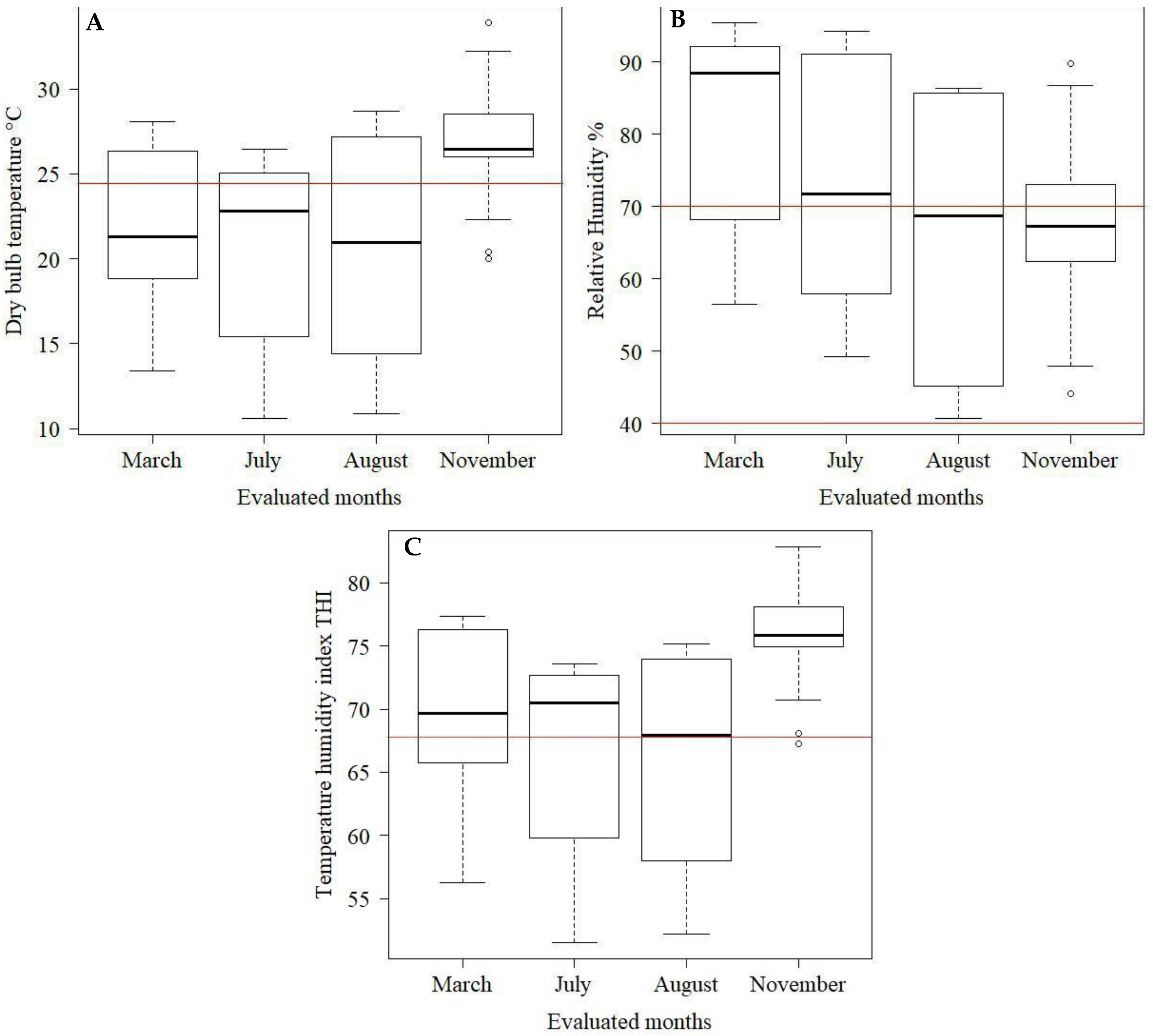
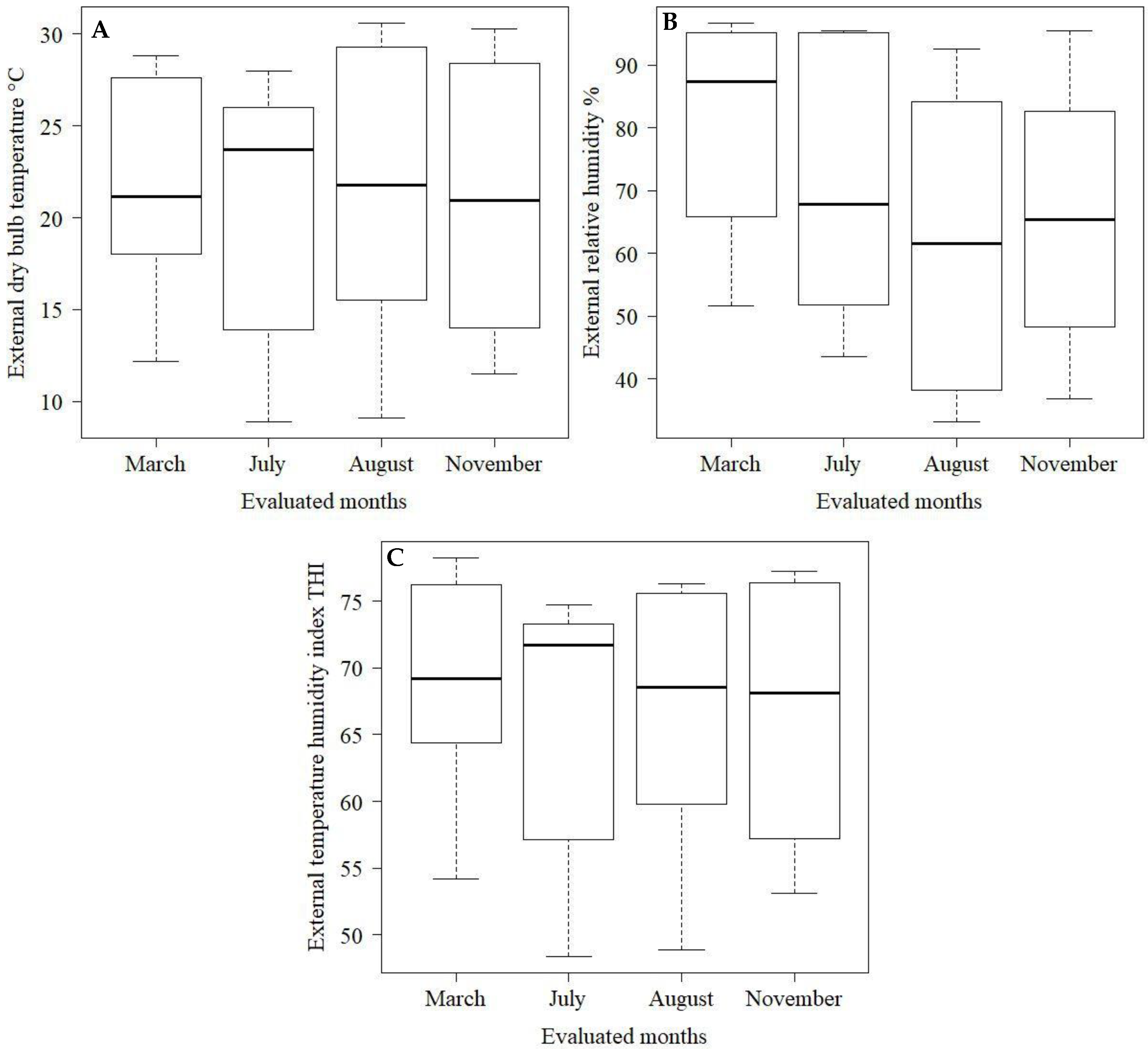
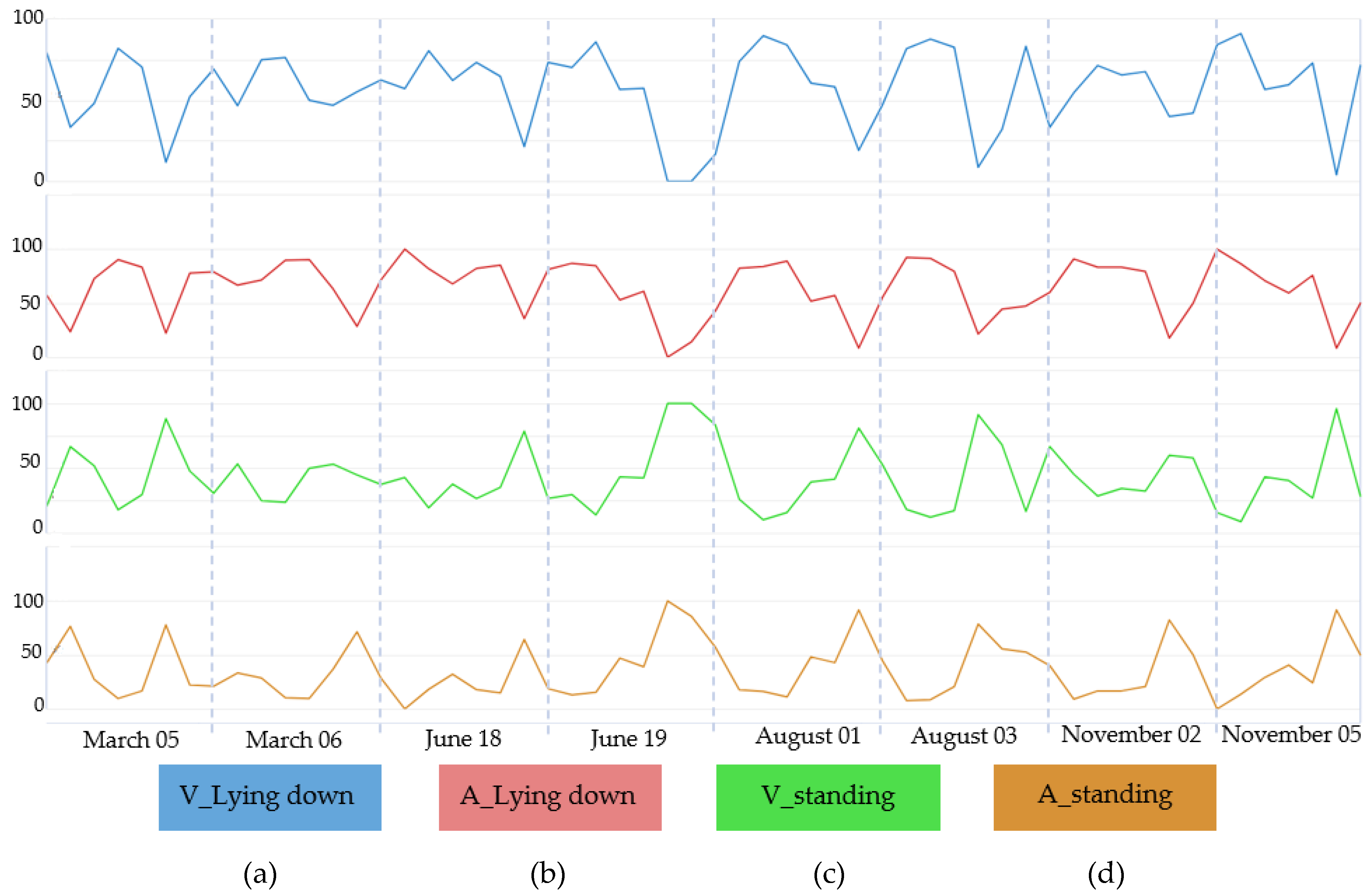
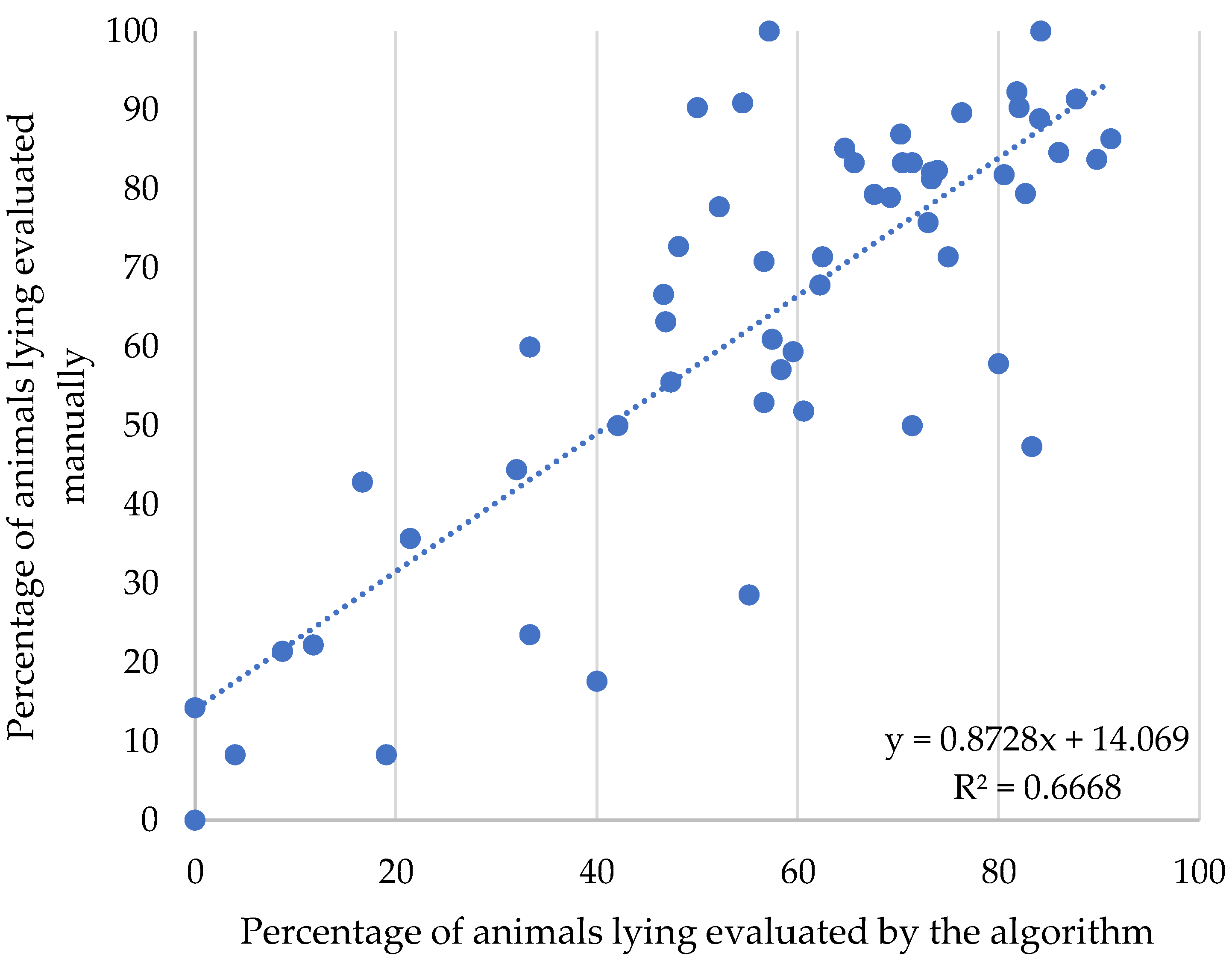
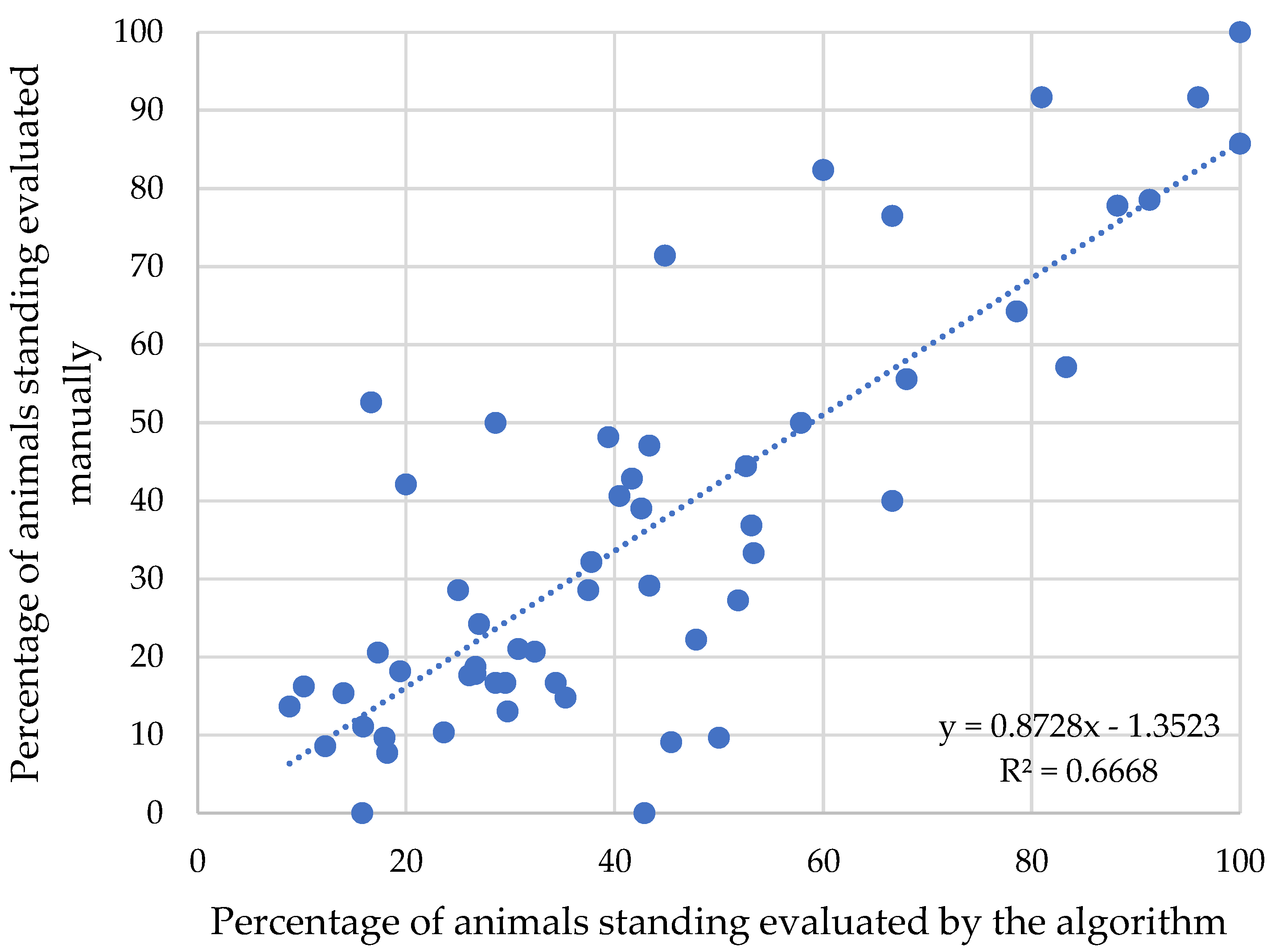
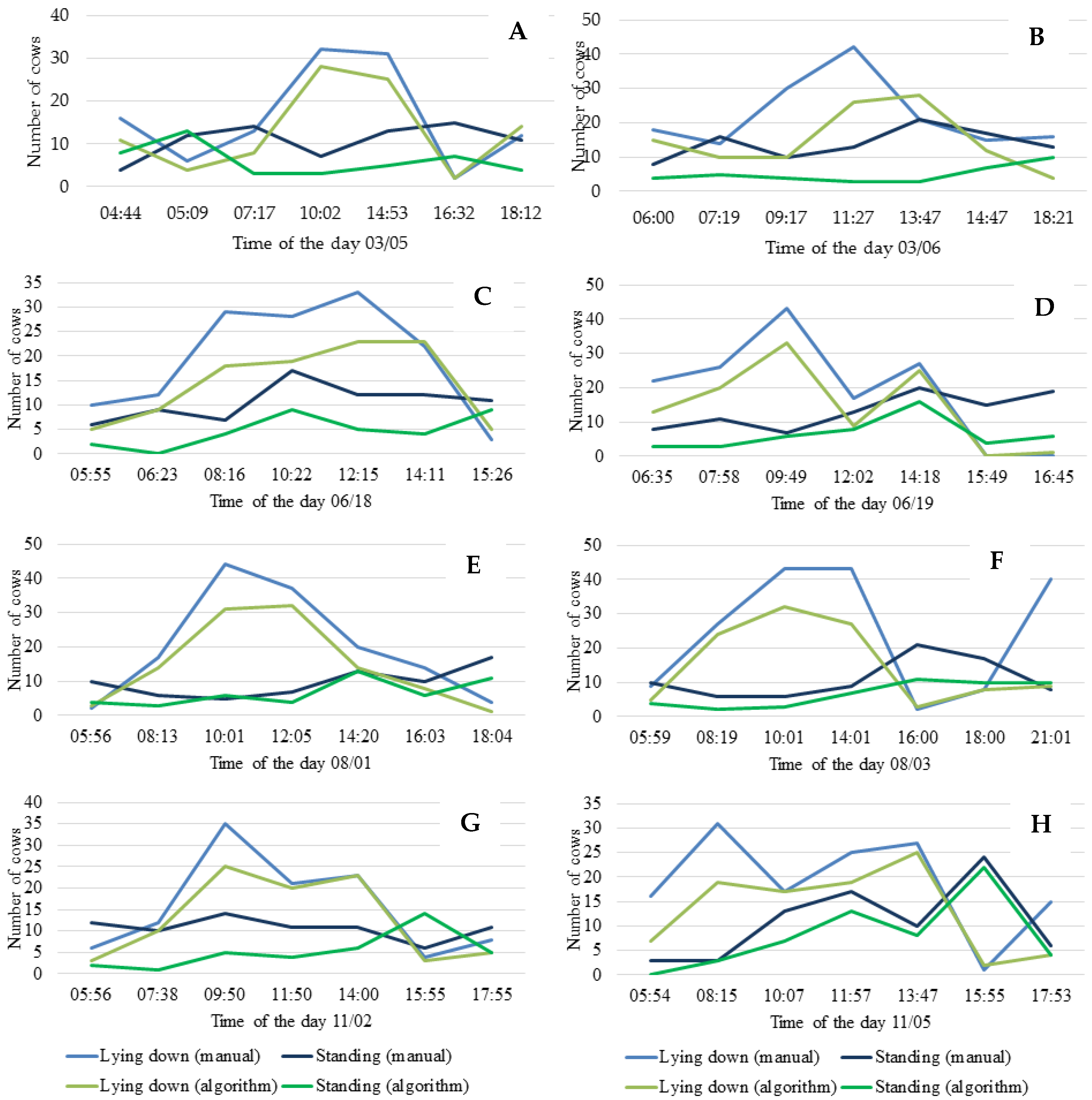
| Summer | Autumn | ||||||
|---|---|---|---|---|---|---|---|
| Day | Time | Day | Time | Day | Time | Day | Time |
| 03/05/2021 | 04:44 | 03/06/2021 | 06:00 | 06/18/2021 | 05:55 | 06/19/2021 | 06:35 |
| 03/05/2021 | 05:09 | 03/06/2021 | 07:19 | 06/18/2021 | 06:23 | 06/19/2021 | 07:58 |
| 03/05/2021 | 07:17 | 03/06/2021 | 09:17 | 06/18/2021 | 08:16 | 06/19/2021 | 09:49 |
| 03/05/2021 | 10:02 | 03/06/2021 | 11:27 | 06/18/2021 | 10:22 | 06/19/2021 | 12:02 |
| 03/05/2021 | 14:53 | 03/06/2021 | 13:47 | 06/18/2021 | 12:15 | 06/19/2021 | 14:18 |
| 03/05/2021 | 16:32 | 03/06/2021 | 14:47 | 06/18/2021 | 14:11 | 06/19/2021 | 15:49 |
| 03/05/2021 | 18:12 | 03/06/2021 | 18:21 | 06/18/2021 | 15:26 | 06/19/2021 | 16:45 |
| Winter | Spring | ||||||
| Day | Time | Day | Time | Day | Time | Day | Time |
| 08/01/2021 | 05:56 | 08/03/2021 | 05:59 | 11/02/2021 | 05:56 | 11/05/2021 | 05:54 |
| 08/01/2021 | 08:13 | 08/03/2021 | 08:19 | 11/02/2021 | 07:38 | 11/05/2021 | 08:15 |
| 08/01/2021 | 10:01 | 08/03/2021 | 10:01 | 11/02/2021 | 09:50 | 11/05/2021 | 10:07 |
| 08/01/2021 | 12:05 | 08/03/2021 | 14:01 | 11/02/2021 | 11:50 | 11/05/2021 | 11:57 |
| 08/01/2021 | 14:20 | 08/03/2021 | 16:00 | 11/02/2021 | 14:00 | 11/05/2021 | 13:47 |
| 08/01/2021 | 16:03 | 08/03/2021 | 18:00 | 11/02/2021 | 15:55 | 11/05/2021 | 15:55 |
| 08/01/2021 | 18:04 | 08/03/2021 | 21:01 | 11/02/2021 | 17:55 | 11/05/2021 | 17:53 |
| Scheme 73 | Percentage |
|---|---|
| Summer | 73% |
| Autumn | 54% |
| Winter | 69% |
| Spring | 55% |
| Date | Visual Method | Algorithm Method | ||
|---|---|---|---|---|
| Lying | Standing | Lying | Standing | |
| March/05 | 16.00 a | 10.85 b | 13.14 c | 6.14 d |
| March/06 | 22.28 a | 14.00 b | 15.00 c | 5.14 d |
| June/18 | 19.57 a | 10.57 b | 14.57 c | 4.71 d |
| June/19 | 19.28 a | 13.28 b | 14.42 c | 6.57 d |
| August/01 | 19.71 a | 9.71 b | 14.71 c | 6.71 d |
| August/03 | 24.57 a | 11.00 b | 15.42 c | 6.71 d |
| November/02 | 15.57 a | 10.71 b | 12.71 c | 5.28 d |
| November/05 | 18.85 a | 10.85 b | 13.28 c | 8.14 d |
Publisher’s Note: MDPI stays neutral with regard to jurisdictional claims in published maps and institutional affiliations. |
© 2022 by the authors. Licensee MDPI, Basel, Switzerland. This article is an open access article distributed under the terms and conditions of the Creative Commons Attribution (CC BY) license (https://creativecommons.org/licenses/by/4.0/).
Share and Cite
Laurindo, G.M.; Ferraz, G.A.e.S.; Damasceno, F.A.; Nascimento, J.A.C.d.; Santos, G.H.R.d.; Ferraz, P.F.P. Thermal Environment and Behavior Analysis of Confined Cows in a Compost Barn. Animals 2022, 12, 2214. https://doi.org/10.3390/ani12172214
Laurindo GM, Ferraz GAeS, Damasceno FA, Nascimento JACd, Santos GHRd, Ferraz PFP. Thermal Environment and Behavior Analysis of Confined Cows in a Compost Barn. Animals. 2022; 12(17):2214. https://doi.org/10.3390/ani12172214
Chicago/Turabian StyleLaurindo, Geovani Marques, Gabriel Araújo e Silva Ferraz, Flavio Alves Damasceno, Joao Antônio Costa do Nascimento, Gabriel Henrique Ribeiro dos Santos, and Patrícia Ferreira Ponciano Ferraz. 2022. "Thermal Environment and Behavior Analysis of Confined Cows in a Compost Barn" Animals 12, no. 17: 2214. https://doi.org/10.3390/ani12172214
APA StyleLaurindo, G. M., Ferraz, G. A. e. S., Damasceno, F. A., Nascimento, J. A. C. d., Santos, G. H. R. d., & Ferraz, P. F. P. (2022). Thermal Environment and Behavior Analysis of Confined Cows in a Compost Barn. Animals, 12(17), 2214. https://doi.org/10.3390/ani12172214






